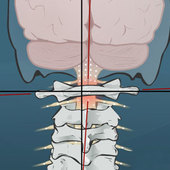A bad night’s sleep affects everything about your day. One of the first questions many patients ask us is how to optimize sleep position to minimize the stress on their neck. In order to capitalize on the quality of how you spend one-third of your day, you must consider your sleep position and picking the right pillow and mattress.
Neck and back pain continue to be the leading cause of years lived with a disability; combine that with an increasing percentage of people who are suffering, and making a smart decision around your sleep habits is critical. Many people wake up with neck pain and back stiffness, and starting the day that way is definitely not ideal.

Your pillow and bed work together
How your bed and pillow interact affects your ability to choose the right sleep position. Generally, the thicker the topper on your bed, the thinner the pillow that you need. Too thin a topper can create stress in the lower back for back sleepers, but too thin a topper can stress the shoulders and neck of side sleepers. Also remember, the materials that the toppers and pillows are made from degrade over time; these changes can result in gradually increasing discomfort. Instead of buying a topper that comes on your mattress, chose an after-market topper that fits best with your sleeping position and replace it when it has lived a good life.
How to choose a pillow?
Before making a proper pillow choice, the first step is to determine how you sleep best. Your sleep position preferences are particularly important, and it is crucial that you listen to your body. Be sure to not accept pain or irritation from sleep unless it is just for a short time or due to extenuating circumstances. Sometimes an orthopedic pillow that is trying to help make a structural shift can create some short term discomfort, but unless there is a good reason to do so, and you’re working with a clinician that can advise you, don’t push through pain during sleep.
A review was published recently investigating past studies on the best sleep position to minimize spinal pain. Unfortunately, one of the findings was that there weren’t enough studies done to answer this question definitively, but even so, they were still able to provide some insight.
What the authors of this review found is that to minimize neck pain, the best sleeping posture is to lie on your side. The side-lying position was also recommended, along with sleeping on your back, for those with lower back pain. One thing is for sure – sleeping on your stomach is to be avoided as it is not good for either your neck or your lower back.
The number one mistake sleepers make
Unless, while on your back, you’re using an orthopedic pillow to support your neck curvature, you should be sleeping on your side to minimize sleep-related pain.
At the Vital PostureTM Clinic, we are obsessed with your posture - both when you’re awake and when you’re asleep! If you feel you have a posture problem, stop in so we can do our best to help you find a solution.
Trust us with your difficult posture problem
When you have a complicated postural issue that isn’t responding to conservative care, leave it to us to help gather a team that will allow you to find relief from your postural issue and recover your health.
Cary D, Briffa K, McKenna L. Identifying relationships between sleep posture and non-specific spinal symptoms in adults: A scoping review. BMJ Open. 2019 Jun 28;9(6):e027633. doi: 10.1136/bmjopen-2018-027633. PMID: 31256029; PMCID: PMC6609073.

Dr. Jeff Scholten
NUCCA Chiropractor
The Vital Posture™ Clinic
Calgary, Canada



